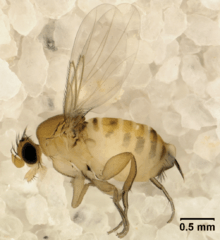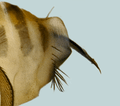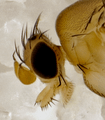Apocephalus borealis
| Apocephalus borealis | |
|---|---|
 | |
| Adult female A. borealis next to grains of sugar for size comparison, note the ovipositor | |
| Scientific classification | |
| Kingdom: | Animalia |
| Phylum: | Arthropoda |
| Class: | Insecta |
| Order: | Diptera |
| Family: | Phoridae |
| Tribe: | Metopininae |
| Genus: | Apocephalus |
| Species: | A. borealis |
| Binomial name | |
| Apocephalus borealis Brues, 1924[1] | |
Apocephalus borealis is a species of North American parasitoid phorid fly that parasitizes bumblebees, honey bees, and paper wasps. These flies are colloquially known as zombie flies and the bees they infect are colloquially known as zombees.[2] The association with honey bees has so far only been documented from California, South Dakota, Oregon, Washington, and British Columbia (Vancouver Island);[3] elsewhere, they are primarily associated with bumblebees and paper wasps, but most recently this species has changed host and has begun to attack the European honey bee. A case was confirmed in October 2013 of an infestation of honeybees in Vermont.[4]
History
The infection of European honey bees in North America by A. borealis was first discovered by Dr. John Hafernik, who noticed disoriented honey bees at a light at night on San Francisco State University's campus. He picked some up in a vial, forgot about them, and about a week later noticed that fly larvae had emerged from the dead bees.[5] Information is insufficient as to why the parasitic fly jumped to its new host, but concern exists that this new host provides an opportunity for the fly to thrive and further threaten the decreasing honey bee population.[6] A. borealis has been suggested as a possible vector promoting the spread of the pathogens responsible for colony collapse disorder.[7][8]
Lifecycle
Female flies lay their eggs in the bees, and as the larvae develop, they attack the bees' brains and cause them to become disoriented. Infected bees can be found walking in circles, as well as losing the ability to stand. The honey bees also remain inactive during the daytime until death occurs. The infected bees are also known to fly at night and exhibit other unusual behaviors such as hive abandonment in unusual weather conditions such as cold, rainy nights when most insects remain inactive.[9] These behaviors eventually result in the death of the bees, but increase the survival and spread of the phorid flies. Female phorid flies immediately attack honey bees when put together. Females attack and pursue host honey bees until they land on their abdomens and insert the ovipositor for about two to four seconds, injecting eggs. Development of larvae takes an average of a week; the larvae feed on the honey bees' muscles and nervous system. Mature fly larvae typically emerge from the host between the head and thorax (but rarely result in decapitation), and pupate outside the host body. About 28 days are needed for the entire lifecycle to take place.[7]
-

Ovipositor of an A. borealis
-

Female A. borealis ovipositing eggs into the abdomen of a worker honey bee
-

Two final-instar larvae of A. borealis exiting a honey bee worker at the junction of the head and thorax
-

Adult female A. borealis
-

Head of an A. borealis
.pdf.jpg)
Zombee Watch
A citizen project, "Zombee Watch", now uses a social media framework for people to report sightings of potentially parasitized bees.[5] The stated goals of the project are to determine where in North America the zombie fly is parasitizing honey bees, how often honey bees leave their hives at night (even if they are not parasitized), and to engage citizen scientists in making a significant contribution to knowledge about honey bees and to become better observers of nature.[10]
References
- 1 2 Brues, C. T. (1924). "Notes on Some New England Phoridæ (Diptera)". Psyche: A Journal of Entomology. 31: 41–44. doi:10.1155/1924/42175.
- ↑ Kayla Figard (August 2, 2012). "Seeking Zombee Hunters". The San Francisco Examiner. p. 12.
- ↑ Sandi Doughton (September 26, 2012). "Start's first case of 'zombie bees' found in Kent". The Seattle Times.
- ↑ Ben Gittleson (January 30, 2014). "'Zombie' Bees Surface in the Northeast". ABC News.
- 1 2 TedTalk (October 31, 2012). "Flight of the Living Dead: Dr. John Hafernik". TedTalk.
- ↑ Anton Preston Arce, Rojelio Pedraza (2012). "Evaluation of Phorid Fly (Apocephalus borealis) Parasitism of Feral Honey Bee (Apis mellifera) Colonies in South Orange County.". KSBR and the Department of Biological Sciences,Saddleback College.
- 1 2 Core, Andrew; Runcke, Charles; Ivers, Jonathan; Quock, Christopher; Siapno, Travis; DeNault, Seraphina; Brown, Brian; DeRisi, Joseph; Smith, Christopher D.; Hafernik, John. "A new threat to honey bees, the parasitic phorid fly Apocephalus borealis". PLoS ONE. 7 (1): e29639. doi:10.1371/journal.pone.0029639. PMC 3250467
 . PMID 22235317.
. PMID 22235317. - ↑ Andy Coghlan (January 3, 2012). "Parasitic fly could account for disappearing honeybees". New Scientist.
- ↑ Castro, Joseph. "Fly Parasite Turns Honeybees Into Zombies | LiveScience".
- ↑ "Zombee Watch". Zombee Watch.
| Wikimedia Commons has media related to Apocephalus borealis. |
External links
- ZomBee Watch is a citizen science project sponsored by the San Francisco State University Department of Biology, the San Francisco State University Center for Computing for Life Sciences and the Natural History Museum of LA County.